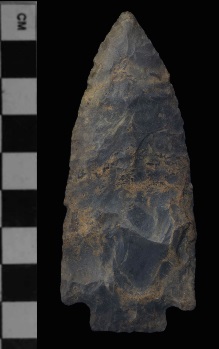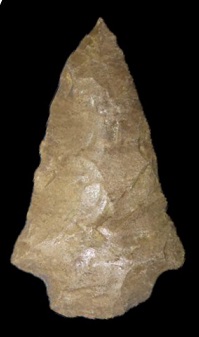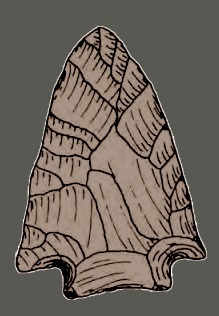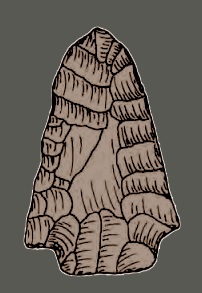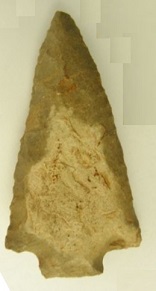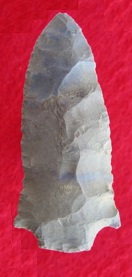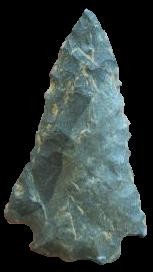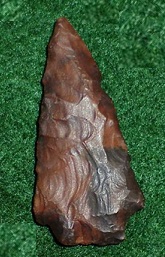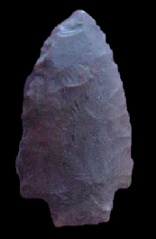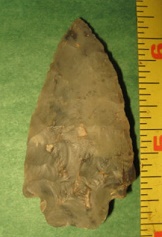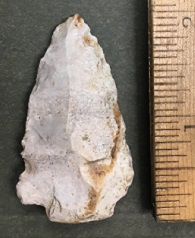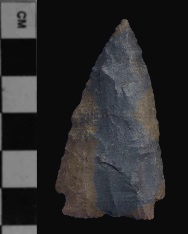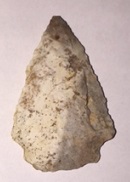Outline is Representative of Size and Shape:

Name Details:
Identified By: David Hulse (in DeJarnette, Kurjack, and Cambron, 1962)
Named For: White Springs area of the Tennessee River
Date Identified: 1961
Type Site: Hulse Site 17, Limestone County, Tennessee
Identified By: David Hulse (in DeJarnette, Kurjack, and Cambron, 1962)
Named For: White Springs area of the Tennessee River
Date Identified: 1961
Type Site: Hulse Site 17, Limestone County, Tennessee
Point Validity:
Valid type
Hulse is a renowned avocational archaeologist who did extensive work in Alabama. This point was named in a personally published book. This point has been referred to in numerous professional publications and is considered a valid type.
Hulse is a renowned avocational archaeologist who did extensive work in Alabama. This point was named in a personally published book. This point has been referred to in numerous professional publications and is considered a valid type.
White Springs Stemmed
Cluster: White Springs Cluster Description of Physical Characteristics and Flaking Pattern:
This is a thin medium triangular stemmed point with a flattened cross section. Infrequently, the cross section may be elliptical. The blade is primarily excurvate, but may range to straight. Rarely, incurvate blades may be seen on re-sharpened examples. Shallow notches are created by removal of the corners of a triangular platform leaving shoulders that are horizontal to slightly sloped downwards, but not barbed. The stem may range from straight to slightly expanding. The stem is short and broad. The base is primarily straight, but may vary to slightly concave. This point has a random flaking pattern. Basal grinding and thinning may be seen on these points.
Size Measurements:
Total Length - 25 to 66 mm (40 to 50 mm average), Stem Length- 3 to 12 mm (6 to 8 mm average), Blade Width - 18 to 36 mm (19 to 32 mm average), Stem Width at Shoulders - 12 to 25 mm (17 to 21 mm average), Basal Width - 11 to 25 mm (18 to 20 mm), Thickness - 3 to 10 mm
Total Length - 25 to 66 mm (40 to 50 mm average), Stem Length- 3 to 12 mm (6 to 8 mm average), Blade Width - 18 to 36 mm (19 to 32 mm average), Stem Width at Shoulders - 12 to 25 mm (17 to 21 mm average), Basal Width - 11 to 25 mm (18 to 20 mm), Thickness - 3 to 10 mm
Commonly Utilized Material:
Quartz, cherts, and quartzite
Quartz, cherts, and quartzite
Additional Comments:
Cambron and Hulse (1964), suggest an association with this point and the Benton Stemmed and Buzzard Roost Creek point. The Benton Stemmed point is thought to have been used following this point as well as the Buzzard Roost Creek point.
This point evolved into the Sykes point. However, this point seems to be more refined with a higher quality of workmanship (Justice, 1987).
White Springs are similar to the Sykes point, but the White Springs tends to have a smaller stem that is basally thinned while the Sykes point tend to have a slightly longer stem with basal thinning less commonly seen (MaGahey, 2000).
Cambron and Hulse (1964), suggest an association with this point and the Benton Stemmed and Buzzard Roost Creek point. The Benton Stemmed point is thought to have been used following this point as well as the Buzzard Roost Creek point.
This point evolved into the Sykes point. However, this point seems to be more refined with a higher quality of workmanship (Justice, 1987).
White Springs are similar to the Sykes point, but the White Springs tends to have a smaller stem that is basally thinned while the Sykes point tend to have a slightly longer stem with basal thinning less commonly seen (MaGahey, 2000).
Distribution: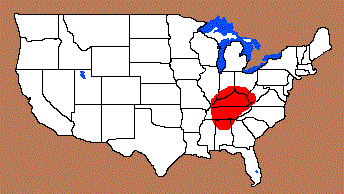
Distribution Comments:
This point is primarily found in the Tennessee River Valley. This point is found into the lower Ohio River Valley with decreased frequency.
This point is primarily found in the Tennessee River Valley. This point is found into the lower Ohio River Valley with decreased frequency.
Age / Periods:
Date: 7,000 - 6,000 B.P.
Cultural Period: Middle Archaic
Glacial Period: Middle Holocene
Culture:
Date: 7,000 - 6,000 B.P.
Cultural Period: Middle Archaic
Glacial Period: Middle Holocene
Culture:
Age Details:
Webb (1998) estimated the date range of 6400 to 4,100 B.P. for White Spring points in Georgia.
Faulkner and McCollough (1973) provide a date range of approximately 6,000 to 4,000 B.P. for White Springs points.
Webb (1998) estimated the date range of 6400 to 4,100 B.P. for White Spring points in Georgia.
Faulkner and McCollough (1973) provide a date range of approximately 6,000 to 4,000 B.P. for White Springs points.

